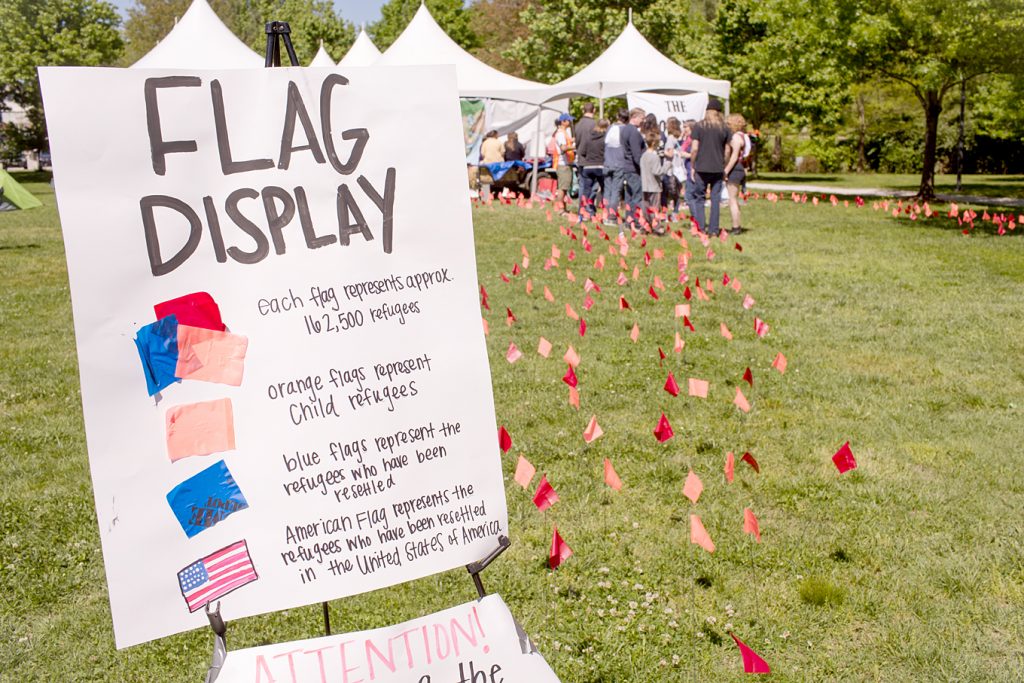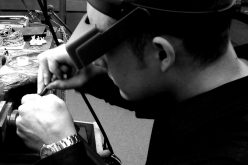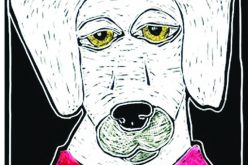-
Photo by Lauren Husband Photography
Leading up to the entrance of the mock refugee camp was a flag display that represented the amount of refugees today and how many of those end up resettled, or resettled in the United States.
I was one of the 2.7 million refugees fleeing Afghanistan at the University of Arkansas Students for Refugees mock refugee camp Sunday, April 23.
When I first arrived to the event, I was given a mock Republic of Afghanistan passport, and a backpack with my belongings: old family photos, a first aid kit, children’s toys, clothes and a journal. I was with a group of six or so, who were given passports from the Democratic Republic of the Congo, Syria and Iraq.
While we each represented the majority countries, there are 65.3 million forcibly displaced people worldwide, the highest on record, according to the UN Refugee Agency (UNHCR). Fewer than 1 percent of refugees are resettled, and the US resettled 1,026 people from Oct. 1, 2016 through March 31, 2017.
Our first stop had us crowd into a wagon that emulated the rafts many refugees take across the Mediterranean Sea to travel to Europe. About 300,000 refugees take that risky route a year, according to UNHCR. We were told about how many refugees are tricked into buying cheaper, fake life vests that absorb water rather than float. More than 5,000 lives have been lost in the Mediterranean since 2014, which the students represented with a memorial of shoes representing the lives lost.

Photo by Lauren Husband Photography
The first step of the mock refugee camp was climbing aboard a “raft” and learning about the hundreds of thousands of refugees who brave the Mediterranean Sea. More than 5,000 lives have been lost in the Mediterranean since 2014, some of which due to incompetent, fake life vests being sold to refugees at cheaper prices.
When we “arrived,” we were arbitrarily given a number that corresponded to the amount of items we lost at sea — I was lucky with a zero — and a card depicting our fate. In my hypothetical, the ship capsized. While I survived, two of my family members were missing and I lost my identification. Because of that, I now risked detention or expulsion from the country I arrived in.
What followed was a series of booths representing the different aspects of life in a refugee camp. We learned about the plights of refugees in several stations regarding medical issues (I had broken limbs, a common ailment), food security (I had iron deficiency), how rampant sex trafficking is in the camps, child care, the limited water rations and sanitation standards and mental health (I had adjustment disorders, essentially rendering me emotionally insecure and anxiety-ridden). Each station had more and more troubling statistics.
At the end, we were dealt our fate cards. Somehow, I won the lottery, and I was the only one to resettle to the United States and move to Arkansas with the help of Canopy NWA, a local resettling agency. Others either were stuck in the camps, told to move back or resettle in the country they fled to if they survived.
In order to be considered a refugee, they have to be someone who has been forced to flee his or her country because of persecution, war, or violence for reasons of race, religion nationality, political opinion or membership in a particular social group.
About 500 people turned out for the event, and there was a constant flow of attendance.

Photo by Lauren Husband Photography
Dozens of volunteers from the UA Students for Refugees organization worked as informational guides throughout the mock refugee camp process. Opportunities for learning more about each topic and how to get involved was offered at each station.
STUDENTS FOR REFUGEES
The mock refugee camp was a product of dozens of student volunteers involved with the Students for Refugees organization at the University of Arkansas.
The group was founded by UA students Jess Garross and Jamie Nix after volunteering at a refugee camp in Lesbos, Greece while studying Arabic abroad in Morocco. While on fall break, the two had seen footage of refugees arriving in rafts on the Greece shore, and it inspired them to help.
“It was scary, we didn’t know what we were getting ourselves into,” Garross said. “It was surprising how much we could help. We helped run the camp and helped translate for other volunteers.”
The day they arrived at the camp, the deadly Paris terrorist attacks of November 2015 took 130 victims. Overnight, the perception of refugees became hostile and negative, and 26 states — including Arkansas — became anti-refugee, blocking all Syrian immigrants temporarily.
“It broke our hearts, because we were spending nine hours a day with these people and hearing their stories, and we were really frustrated with our home country,” Garross said. “We really wanted people to understand what was happening there.”
The main goal for the event was to educate the public about the refugee crisis so that the next time the topic comes up in the news cycle or in a conversation, they’ll be able to speak about what they learned, Garross said.
Mark Snodgrass, an attendee, brought his family along to undergo the experience. He said it was very humbling.
“We’ve got it pretty good, and I thought it was important for my two little boys to know a lot of folks in the world are struggling and to help them understand that,” he said.

Photo by Lauren Husband Photography
Mock refugee camp attendees listen as student volunteers talk about the many issues facing the refugee crisis of today.
The majority of the volunteer students in the mock refugee camp worked on their own scripts throughout the course of two months. One of the goals was to utilize the study majors of the students to a respective topic.
“There’s a quote I came across that says ‘I am one, but I am at least one, and I can’t do everything, but I can do something and that one thing is enough,’” Nix said. “If there’s one thing you can do, educate your friends and family, because there’s so much misinformation out there.”
How to Help the Refugee Crisis
- Visit the UN Refugee Agency at www.unhcr.org for more information
- Donate or volunteer with Canopy NWA, a local resettlement agency, or any of the nine national resettlement agencies
- Advocacy
Common Myths About Refugees
- Myth: The process for admitting refugees to the United States is not secure and terrorists can easily enter the country.
FACT: The most difficult way to get into the United States is as a refugee. No other category of travel goes under as detailed a screening process, which often takes several years.
- Myth: Most refugees are Muslim men.
FACT: More than half of the world’s refugees are children. According to the U.S. Office of Admissions Refugee Processing Center, only 24,768 refugees who arrived between January 2016 and August 2016 were Muslim, while more than 30,000 were of Christian and other faiths.
- Myth: Refugees are a drain on society.
FACT: Refugees start businesses, pay taxes and contribute to their communities. The vast majority of newly resettled refugees quickly find jobs, 85 percent of refugees resettled by the International Rescue Committee were hired within 180 days of arrival.
Source: United States Conference of Catholic Bishops, justiceforimmigrants.org, www.rescue.org











